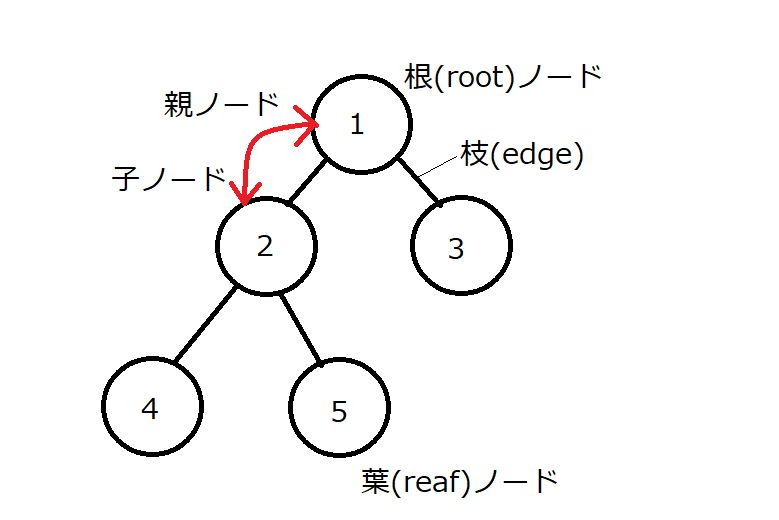ヒープとは
- 半順序集合をツリーで表現したデータ構造
- 「親ノードは子ノードよりも小さい(もしくは大きい)か等しい」という条件を満たすツリー構造
- 一般にヒープといったら二分木を意味する
配列を使ったヒープの実現
インデックスを $1$ から開始すると、ノード $n$ の親ノードは $n/2$、子ノードは $2n$ と $2n+1$ でアクセスできる。
ただし、親ノードのインデックスを計算する除算は小数点以下切り捨て
※インデックスを$0$から開始すると、ノード $n$ の親ノードは $(n-1)/2$、子ノードは $2n+1$ と $2n+2$
ヒープソートとは
-
要素数 $N$ のヒープを、「子よりも親が大きい」として構築:根が最大値となる
-
根を配列の最後尾と入れ替える。
-
$N-1$ 個の要素のヒープを構築しなおす:根が2番目に大きい値となる
$\vdots$
ヒープの再構築
根を配列の後ろの要素と入れ替えた後は、先頭要素(根)を除いてヒープ構造ができている。
次の手順を、根ノードから開始
- 大きいほうの子と比較
- 親が大きければヒープ構築済み
- 親が小さければ子と入れ替えて、さらに下の子と比較
自分より大きな子と入れ替えて、自身を下に下げながらヒープを構築する位置までおろしていく:pushdown操作
配列全体のヒープ化
ヒープソートを行うには、配列がヒープ構造になっていることが前提
- 下から、ボトムアップ的にヒープ化する
- pushdown操作を使ってヒープ化できる
- 要素 $N$ とすると、最初に $N/2$ (最後のノードの親)をヒープ化する
- $N/2,N/2-1,N/2-2,\cdots,2,1$ の順にpushdownしていく
サンプルコード
ここでは、int型の配列を、ヒープソートを用いて小さい順に整列する。
※整列する部分は配列の添え字が1から10までです。
heap_sort.c
# include<stdio.h>
/* 値を入れ替える関数 */
void swap (int *x, int *y) {
int temp; // 値を一時保存する変数
temp = *x;
*x = *y;
*y = temp;
}
/* pushdouwn操作 */
void pushdown (int array[], int first, int last) {
int parent = first; // 親
int child = 2*parent; // 左の子
while (child <= last) {
if ((child < last) && (array[child] < array[child+1])) {
child++; // 右の子の方が大きいとき、右の子を比較対象に設定
}
if (array[child] <= array[parent]) { break; } // ヒープ済み
swap(&array[child], &array[parent]);
parent = child;
child = 2* parent;
}
}
/* ヒープソート */
void heap_sort (int array[], int array_size) {
int i;
for (i = array_size/2; i >= 1; i--) {
pushdown(array, i, array_size); // 全体をヒープ化
}
for (i = array_size; i >= 2; i--) {
swap(&array[1], &array[i]); // 最大のものを最後に
pushdown(array, 1, i-1); // ヒープ再構築
}
}
int main (void) {
int array[11] = { 0, 2, 1, 8, 5, 4, 7, 9, 10, 6, 3 };
int i;
printf("Before sort: ");
for (i = 1; i < 11; i++) { printf("%d ", array[i]); }
printf("\n");
heap_sort(array, 10);
printf("After sort: ");
for (i = 1; i < 11; i++) { printf("%d ", array[i]); }
printf("\n");
return 0;
}
実行結果
Before sort: 2 1 8 5 4 7 9 10 6 3
After sort: 1 2 3 4 5 6 7 8 9 10
性能
- 先頭要素を取り出すだけで最大値を求めることができる
- 残った要素を再ヒープ化する必要がある
- この計算量は$O(\log{n})$
- この操作を全要素に対して行うので、全体としての計算量は$O(n\log{n})$
- 作業領域を節約できるので、効率のいいソートが実現可能
- 整列のための特別な作業領域を必要としない
- クイックソートのような再帰処理を必要としない

